|
Rise and fall of Prabhakaran:
How terrorism haunted the land of beauty
Indeewara THILAKARATHNE
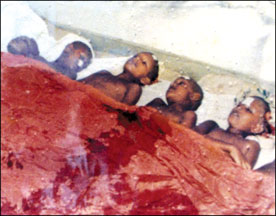 |
|
Arantalawa massacre |
The death of Pirabhakaran will not only mark the end of terrorism in
Sri Lanka, but will also herald a new era of peace and prosperity.
However, harrowing memory of cold blooded murders, suicide bomb blasts
and killing of farmers in threatened villages will haunt in the minds of
thousands of Sri Lankans who unfortunately had to witness these carnages
for over three decades.
It is also pertinent here to look into the ideology and the life and
time of Pirabhakaran - the megalomaniac who stood for an illusive
separate state of Eelam. Although the ideology of Eelam goes back to the
pre-independence days as far back as 1960s - 70s, the riots of 1983 July
was a catalyst in the struggle for a separate state of Eelam. As
subsequently we came to know, the black July of 1983 was triggered by
LTTE’s ambush on a convoy of soldiers in Tinnevely in Jaffna peninsula,
killing 13 soldiers. The backlash was one of the darkest hours in the
contemporary history of Sri Lanka in which large number of Tamils were
killed and attacked by armed groups. The goons were not only armed with
iron clubs but also carried electoral lists with them.
The fact that the goons carried electoral lists was subsequently
attributed to Government’s hand in the attacks on the Tamils. The
backlash of 1983 was counterproductive on many accounts. It was the main
contributory factor in the birth of a strong Tamil Diaspora that fuelled
the inferno at home with its generous financial and logistical aid.
Pirabhakaran has also been greatly influenced by the 1958 racial
riots and atrocities committed on Tamils. However, Pirabhakaran’s
subsequent killing spree could not be justified in the name of
liberation or his much aired aim of establishing a separate state for
Tamils in Sri Lanka.
The excerpts of the Indian Journalist Anita Pratap’s interview with
Pirabhakaran at the early stage of his struggle will shed light on his
ideology and the character.
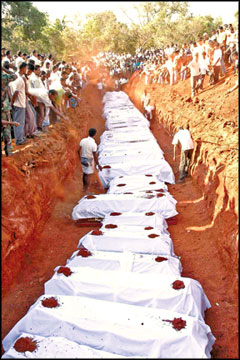 |
|
Kebithigollewa massacre |
Anita states in her book “Island of Blood” that Pirabhakaran has
always been very secretive about his personal details, about his family,
his childhood, his upbringing. Once I asked him to tell me what in his
personal life had convinced him that an armed struggle alone would
deliver the Tamils from Sinhala domination. He recounted images from the
1958 anti-Tamil riots that had left a deep impression on him. He was
only four years old then. The shocking events of the 1958 racial riots
had a profound impact on me. I heard of horrifying incidents of how our
people had been mercilessly and brutally put to death by Sinhala
racists. Once I met a widowed mother, a friend of my family, who related
to me her agonizing personal experience of this racial holocaust. A
Sinhala mob attacked her house in Colombo. The rioters set fire to the
house and murdered her husband. She and her children escaped with severe
burn injuries. I was deeply shocked when I saw the scars on her body. I
also heard stories of how young babies were roasted alive in boiling
tar. When I heard such stories of cruelty, I felt a deep sense of
sympathy and love for my people. A great passion overwhelmed me to
redeem my people from this racist system. I strongly felt that an armed
struggle was the only way to confront a system which employs armed might
against unarmed and innocent people. “
Pirabhakaran was only seventeen years old when he along with a small
band of Tamil youths, started the TNT (Tamil New Tigers) in 1972 on the
sandy shores of his home town, Velvettithurai. He was known to be a
radical socialist and a committed nationalist. Indian and Sri Lankan
intelligence agencies believe that he received training and assistance
from the Palestine Liberation Organization. He also had the reputation
of an excellent marksman. In 1975, from a distance of 200 feet, he shot
a police inspector named Bastianpillai as he ran, right between the
eyes. The legend Pirabhakaran was born.
Everybody called him Thambi, which in Tamil means brother. He earned
the nickname because he became a revolutionary when still in his teens.
Soon, Thambi became part of common Tamil parlance. All through the
1980s, his colleagues, associates, supporters and even ordinary
civilians who had never met him called him Thambi. People used the
nickname with affection as well as admiration.”
Asked why he had chosen the Tiger as his a symbol, Pirabhakaran has
said: “I named the movement Liberation Tigers since the Tiger emblem has
deep roots in the political history of the Tamils, symbolizing Tamil
patriotic resurgence. The Tiger symbol also depicts the mode of our
guerrilla warfare.’ The symbol is borrowed from the imperial crest of
the `Chola’ dynasty, a line of aggressive Tamil conquerors from India,
who in the eleventh century sought to extend their influence to the
territories that now form northern India, Sri Lanka, Java and Sumatra.”
It was clear from the very commencement of the movement that
Pirabhakaran did not believe in democracy or in people’s power. Instead
he firmly believed that physical assassination of his opponents would
clear his way for a separate state. First it was a fight among the Tamil
military groups for dominance. In the bloody struggle, LTTE was able to
annihilate several other Tamil militant groups including EPRLF, EROS
while weakening others.
Although Mayor of Jaffna and SLFP Chief Organiser of Jaffna, Alfred
Duraiyappah’s assassination on July 27 in 1975 was the political killing
by Pirabhakaran himself, thousands of attacks on Sri Lankan civilians
and on economic targets with the aim of de-establishing the country are
still afresh in the people’s memory as the body of Pirabhakaran was
flashed on televisions’ screens.
Although it is not possible to revisit numerous attacks ordered by
Piraphakaran and executed by his frenzied human bombs, it is pertinent
here to recall, at least, the major attacks which formed the local and
international perception of the terror outfit as the most dangerous and
ruthless terrorist organization in the world.
Massacre in Anuradhapura
The LTTE launched its first major attack on civilians in the sacred
city of Anuradhapura. It took place on May 14, 1985 when LTTE killed 146
Sinhalese men, women and children in Anuradhapura. The LTTE entered the
city by a hijacked bus and as they entered the bus station, they opened
fire indiscriminately on people waiting for buses. Thereafter, LTTE
cadres stormed Sri Maha Bodhi and killed Nuns, Monks and civilians
inside the shrine. The attack was aimed at triggering a backlash against
the Tamils in order to prove that Sinhalese are racists. Before
withdrawing, the attackers entered the Wilpattu National Park and killed
18 Sinhalese in the forest reserve.
Arantalawa massacre
|
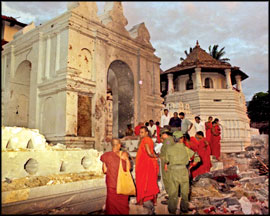 |
|
Attack on the Temple of
the Tooth |
|
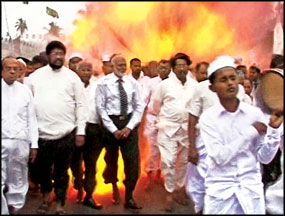 |
|
Suicide attack in
Akuressa |
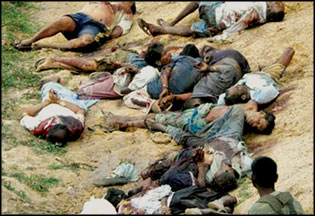 |
|
Massacre of farmers in
Welikanda |
|
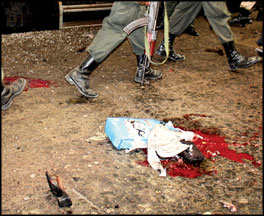 |
|
Attack on Dehiwala
train |
On June 2, 1987, LTTE massacred 33 young Monks and the Chief Priest
Ven. Hegoda Indrasara Thera at Aranthalawa in Ampara. The group of
Buddhist priests were on a pilgrimage to Kelaniya. As the bus reached
Arantalawa, the bus driver sensed danger when he saw wooden logs
blocking the road. Twenty LTTE terrorists emerged from the jungle
wielding swords, knives and machine guns.
They climbed into the bus and butchered the priests.
Massacre in Kattankudi mosque
One of the brutal massacres that LTTE committed was the massacre in
Kattankudi mosque on August 4, 1990. Around 30 Tamil terrorists raided
four mosques in the predominantly Muslim town of Kattankudi while over
300 Muslims were at Isha prayers.
Prior to the attacks a warning was issued to the citizens of
Kattankudi, demanding that Muslims should immediately vacate the town or
face death. It was a part of the master plan of ethnic cleansing.
The Kent and Dollar Farm massacres
According to Eelamists’ theory of the traditional homeland for
Tamils, it was imperative for LTTE to clear those areas of Sinhalese and
Muslims. LTTE argued that government-sponsored settlements of Sinhalese
were aimed at changing the demographic composition of the area. The Kent
and Dollar Farm massacres were examples of this policy.
The LTTE carried out the massacre on November 30, 1984 in two farming
villages known as the Kent and Dollar Farms in the district of
Mullaitivu.
At Dollar Farm, 33 Sinhalese farmers were killed injuring several
others. On the same day, at Kent Farm 29 Sinhalese civilians were shot
dead. LTTE cadres used submachine guns, automatic rifles and hand
grenades to kill the farmers. Survivors reported gruesome tale of LTTE
killing the children by knocking them against walls.
Maradana bomb blast
LTTE killed 50 civilians and injured 200 when a bomb was exploded in
Maradana on March 12, 1998. By series of bombing LTTE was able to
terrorise the country, creating a volatile political and economic
environment in the county.
Temple of the Tooth
In desperation for a communal backlash, LTTE carried out a suicide
attack on temple of the tooth killing 12 and injuring 25 on January 25,
1998. A considerable damage was caused to the Temple though restored
later.
Central Bank bombing
One of the high profile LTTE attacks in the city of Colombo. It was a
prime economic target like the attack on Katunayake Airport. The LTTE
carried out the attack on January 31, 1996. An explosives - laden lorry
carrying about 440 was driven into the central Bank. The blast killed 91
people and injured 1,400.
Attack on BIA
This is one of the bloodiest attacks in the history of terrorism in
Sri Lanka. The attack took place on July 24, 2001. Its adverse impact
was felt hard on country’s economy.
It was planned to coincide with the riots of the Black July of 1983.
Around 3.30 am on July 24, a 14 member black tiger suicide squad
stalled into the airport cutting the barbed wire fence and plunged the
airport into darkness by exploding the transformers. Rocket propelled
grenades and heavy arms were used for the attack. Twenty six aircrafts
were either partially or completely damaged. Eight LTTE cadres and three
Air force officers killed in the attack. |

